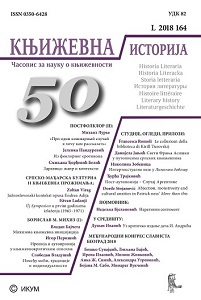Проучавање интертекстуалних веза у роману Гинтера Граса Лимени добош
Examining the Intertextual Relations in Günter Grass’ Novel the Tin Drum
Author(s): Nikolina N. ZobenicaSubject(s): German Literature
Published by: Институт за књижевност и уметност
Keywords: intertextuality;literary influences;parody,;The Tin Drum;Günter Grass;
Summary/Abstract: A highly renowned novel of German writer Günter Grass (1927-2015) Tin Drum (Die Blechtrommel, 1959) has so far been examined from various aspects. As Grass was extraordinarily well-read and familiar not only with German, but also with English, French and Dutch literatures, various influences can be discerned in his first novel. On the one hand, the relations between e Tin Drum and other texts in the German and European literary traditions have been scrutinized in detail, with comparisons establishing a genetic or typological connection among the texts, while on the other hand, numerous role-models and influences relevant for the creation of the work have only been listed. A full overview of these influences and role-models has not been worked out yet. Besides, the relations of Grass’ Tin Drum to other literary and non-literary texts have so far been examined only traditionally, that is, from the aspect of the reconstruction of the process of the text creation, from the hermeneutic and comparative perspectives with the aim of determining the similarities with and di erences from other literary works. The aim of this paper has been to o er an overview of research on intertextuality in the novel e Tin Drum, as well as to enrich it with the post-structural approach according to which literary texts interrelate to each other creating the nets of texts, which build up cultural and literary discourses. The examination of intertextuality in this novel from the aspect of post-structuralism resulted in the conclusion that e Tin Drum has been connected to di erent texts through the imitation and/or parody forming literary discourses of realism and satire (Grimmelshausen, Brecht, utopia and dystopia), classical humanism (Goethe and Schiller), objectifi- cation and dehumanisation in avant-garde and modern art (Döblin, Melville and Jahnn), as well as of existentialism and the absurd (Camus and Sartre). The world depicted in this way motivates Oscar and other literary heroes of the kind in the German and European literatures, to take a marginal position in the society, partly imposed on them through their physical otherness, partly through their talents and abilities. The connection to other texts is built up on the ground of the common motifs, topics, character types, quotations, and allusions, and the result is a highly complex and ambiguous literary work. The examination of intertextuality here can hardly be exhausted, as new texts connect with the existing ones, and new literary discourses are being built up, in which e Tin Drum of Günter Grass can also get (in)directly included in various ways.
Journal: Књижевна историја
- Issue Year: 50/2018
- Issue No: 164
- Page Range: 315-336
- Page Count: 22
- Language: Serbian

